display OPEL CASCADA 2018 Manual user
[x] Cancel search | Manufacturer: OPEL, Model Year: 2018, Model line: CASCADA, Model: OPEL CASCADA 2018Pages: 267, PDF Size: 8 MB
Page 5 of 267

Introduction3Vehicle specific dataPlease enter your vehicle's data on
the previous page to keep it easily
accessible. This information is
available in the sections "Service and
maintenance" and "Technical data"
as well as on the identification plate.
Introduction
Your vehicle is a designed
combination of advanced technology, safety, environmental friendliness
and economy.
This Owner's Manual provides you
with all the necessary information to
enable you to drive your vehicle
safely and efficiently.
Make sure your passengers are
aware of the possible risk of accident
and injury which may result from
improper use of the vehicle.
You must always comply with the
specific laws and regulations of the
country that you are in. These laws
may differ from the information in this Owner's Manual.
Disregarding the description given in
this manual may affect your warranty.When this Owner's Manual refers to a
workshop visit, we recommend your
Opel Service Partner.
All Opel Service Partners provide
first-class service at reasonable
prices. Experienced mechanics
trained by Opel work according to
specific Opel instructions.
The customer literature pack should
always be kept ready to hand in the
vehicle.
Using this manual ● This manual describes all options
and features available for this
model. Certain descriptions,
including those for display and
menu functions, may not apply to
your vehicle due to model
variant, country specifications,
special equipment or
accessories.
● The "In brief" section will give you
an initial overview.
● The table of contents at the beginning of this manual and
within each section shows where the information is located.● The index will enable you to search for specific information.
● This Owner's Manual depicts left-
hand drive vehicles. Operation is similar for right-hand drive
vehicles.
● The Owner's Manual uses the engine identifier code. The
corresponding sales designation
and engineering code can be
found in the section "Technical
data".
● Directional data, e.g. left or right, or front or back, always relate to
the direction of travel.
● Displays may not support your specific language.
● Display messages and interior labelling are written in bold
letters.
Page 13 of 267

In brief111Power windows .....................33
2 Exterior mirrors .....................30
3 Cruise control .....................157
Speed limiter ....................... 159
Forward collision alert .........160
4 Side air vents ...................... 133
5 Turn and lane-change
signals, headlight flash,
low beam and high beam,
high beam assist .................120
Exit lighting ......................... 123
Parking lights ...................... 121
Buttons for Driver
Information Centre ................95
6 Instruments .......................... 85
7 Steering wheel controls .......79
8 Driver Information Centre ...... 95
9 Windscreen wiper,
windscreen washer
system, headlight washer
system ................................... 80
10 Sport mode ........................ 155
Central locking system ..........23Hazard warning flashers ....119
Control indicator for airbag deactivation .......................... 90
Control indicator for front
passenger seat belt .............89
Tour mode .......................... 155
11 Info-Display .......................... 99
12 Anti-theft alarm system
status LED ........................... 28
13 Centre air vents .................. 133
14 Glovebox, lockable ...............70
15 Traction Control system
(TC) ..................................... 153
Electronic Stability Control (ESC) .................................. 154
Parking assist systems .......163
Lane departure warning .....177
Eco button for stop-start
system ................................. 138
16 Climate control system ........ 125
17 AUX input, USB input ..........10
18 Power outlet .......................... 8319Soft top operation switch .....36
Central window switch .........33
20 Selector lever, transmission
21 Parking brake, manual or
electric operation ................151
22 Ignition switch with
steering wheel lock ............137
23 Horn ..................................... 80
Driver airbag ........................ 62
24 Bonnet release lever ..........190
25 Storage compartment ..........71
Fuse box ............................ 207
26 Steering wheel adjustment ..79
27 Light switch ........................ 112
Rear fog light ...................... 120 Instrument illumination .......121
Headlight range
adjustment ......................... 115
Front fog lights ...................120
Page 15 of 267

In brief131Power windows .....................33
2 Exterior mirrors .....................30
3 Cruise control .....................157
Speed limiter ....................... 159
Forward collision alert .........160
4 Side air vents ...................... 133
5 Turn and lane-change
signals, headlight flash,
low beam and high beam,
high beam assist .................120
Exit lighting ......................... 123
Parking lights ...................... 121
Buttons for Driver
Information Centre ................95
6 Instruments .......................... 85
7 Steering wheel controls .......79
8 Driver Information Centre ...... 95
9 Windscreen wiper,
windscreen washer
system, headlight washer
system ................................... 80
10 Sport mode ........................ 155
Central locking system ..........23Hazard warning flashers ....119
Control indicator for airbag deactivation .......................... 90
Control indicator for front
passenger seat belt .............89
Tour mode .......................... 155
11 Info-Display .......................... 99
12 Anti-theft alarm system
status LED ........................... 28
13 Centre air vents .................. 133
14 Glovebox, lockable ...............70
Fuse box ............................. 207
15 Traction Control system
(TC) ..................................... 153
Electronic Stability Control (ESC) .................................. 154
Parking assist systems .......163
Lane departure warning .....177
Eco button for stop-start
system ................................. 138
16 Climate control system ........ 125
17 AUX input, USB input ..........10
18 Power outlet .......................... 8319Soft top operation switch .....36
Central window switch .........33
20 Selector lever, transmission
21 Parking brake, manual or
electric operation ................151
22 Ignition switch with
steering wheel lock ............137
23 Horn ..................................... 80
Driver airbag ........................ 62
24 Bonnet release lever ..........190
25 Storage compartment ..........71
Fuse box ............................ 207
26 Steering wheel adjustment ..79
27 Light switch ........................ 112
Rear fog light ...................... 120
Instrument illumination .......121
Headlight range
adjustment ......................... 115
Front fog lights ...................120
Page 24 of 267
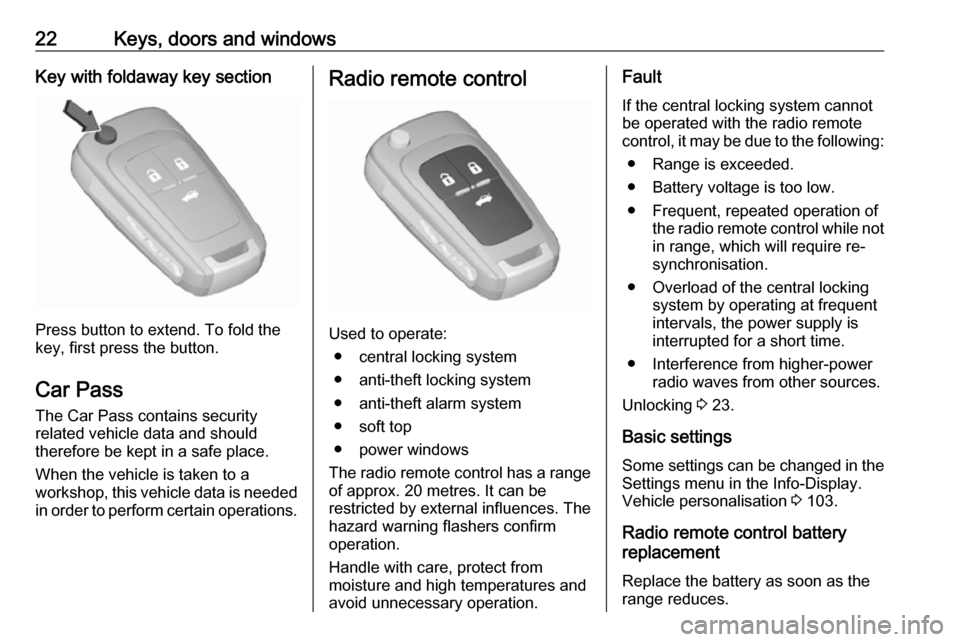
22Keys, doors and windowsKey with foldaway key section
Press button to extend. To fold the
key, first press the button.
Car Pass The Car Pass contains security
related vehicle data and should
therefore be kept in a safe place.
When the vehicle is taken to a
workshop, this vehicle data is needed
in order to perform certain operations.
Radio remote control
Used to operate:
● central locking system
● anti-theft locking system
● anti-theft alarm system
● soft top
● power windows
The radio remote control has a range of approx. 20 metres. It can be
restricted by external influences. The
hazard warning flashers confirm
operation.
Handle with care, protect from
moisture and high temperatures and
avoid unnecessary operation.
Fault
If the central locking system cannot
be operated with the radio remote
control, it may be due to the following:
● Range is exceeded.
● Battery voltage is too low.
● Frequent, repeated operation of the radio remote control while not
in range, which will require re-
synchronisation.
● Overload of the central locking system by operating at frequent
intervals, the power supply is
interrupted for a short time.
● Interference from higher-power radio waves from other sources.
Unlocking 3 23.
Basic settings Some settings can be changed in the
Settings menu in the Info-Display.
Vehicle personalisation 3 103.
Radio remote control battery
replacement
Replace the battery as soon as the
range reduces.
Page 25 of 267
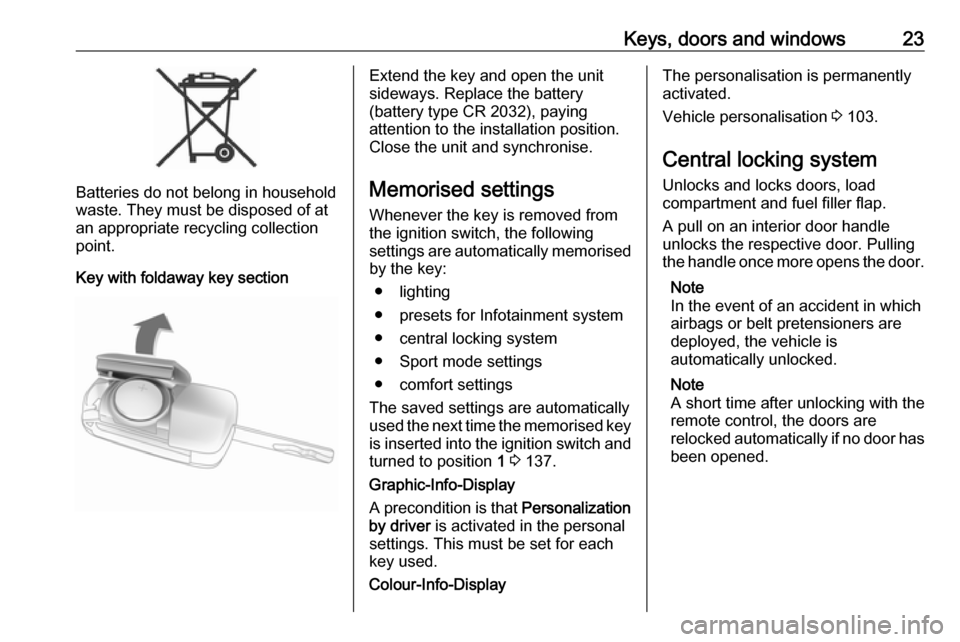
Keys, doors and windows23
Batteries do not belong in household
waste. They must be disposed of at
an appropriate recycling collection
point.
Key with foldaway key section
Extend the key and open the unit
sideways. Replace the battery
(battery type CR 2032), paying
attention to the installation position.
Close the unit and synchronise.
Memorised settings
Whenever the key is removed from
the ignition switch, the following
settings are automatically memorised by the key:
● lighting
● presets for Infotainment system
● central locking system
● Sport mode settings
● comfort settings
The saved settings are automatically
used the next time the memorised key
is inserted into the ignition switch and
turned to position 1 3 137.
Graphic-Info-Display
A precondition is that Personalization
by driver is activated in the personal
settings. This must be set for each
key used.
Colour-Info-DisplayThe personalisation is permanently
activated.
Vehicle personalisation 3 103.
Central locking system
Unlocks and locks doors, load
compartment and fuel filler flap.
A pull on an interior door handle
unlocks the respective door. Pulling the handle once more opens the door.
Note
In the event of an accident in which
airbags or belt pretensioners are
deployed, the vehicle is
automatically unlocked.
Note
A short time after unlocking with the
remote control, the doors are
relocked automatically if no door has
been opened.
Page 26 of 267
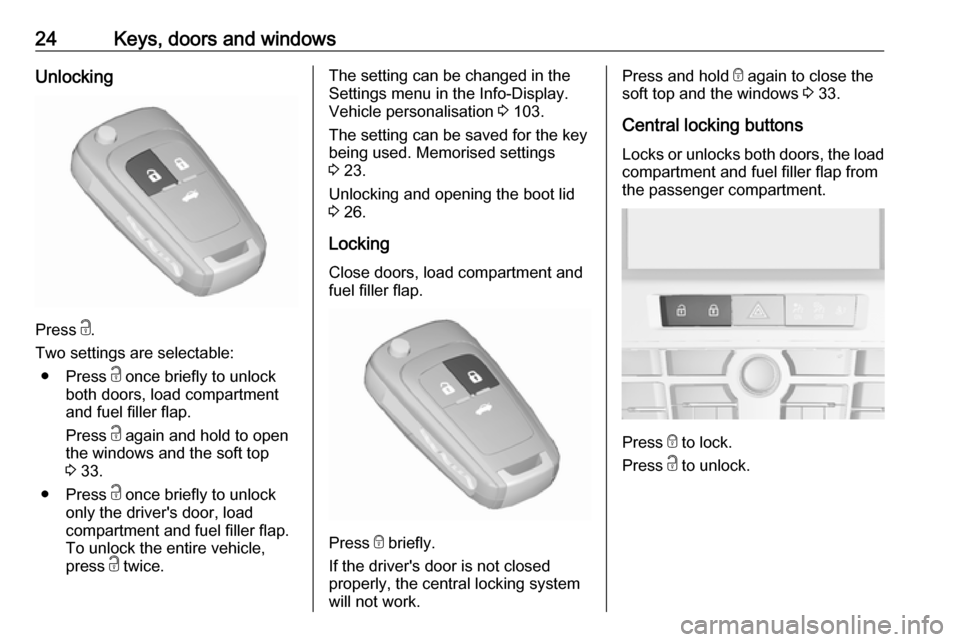
24Keys, doors and windowsUnlocking
Press c.
Two settings are selectable: ● Press c once briefly to unlock
both doors, load compartment
and fuel filler flap.
Press c again and hold to open
the windows and the soft top 3 33.
● Press c once briefly to unlock
only the driver's door, load
compartment and fuel filler flap.
To unlock the entire vehicle,
press c twice.
The setting can be changed in the
Settings menu in the Info-Display.
Vehicle personalisation 3 103.
The setting can be saved for the key
being used. Memorised settings
3 23.
Unlocking and opening the boot lid
3 26.
Locking
Close doors, load compartment and
fuel filler flap.
Press e briefly.
If the driver's door is not closed
properly, the central locking system will not work.
Press and hold e again to close the
soft top and the windows 3 33.
Central locking buttons Locks or unlocks both doors, the load compartment and fuel filler flap from
the passenger compartment.
Press e to lock.
Press c to unlock.
Page 27 of 267
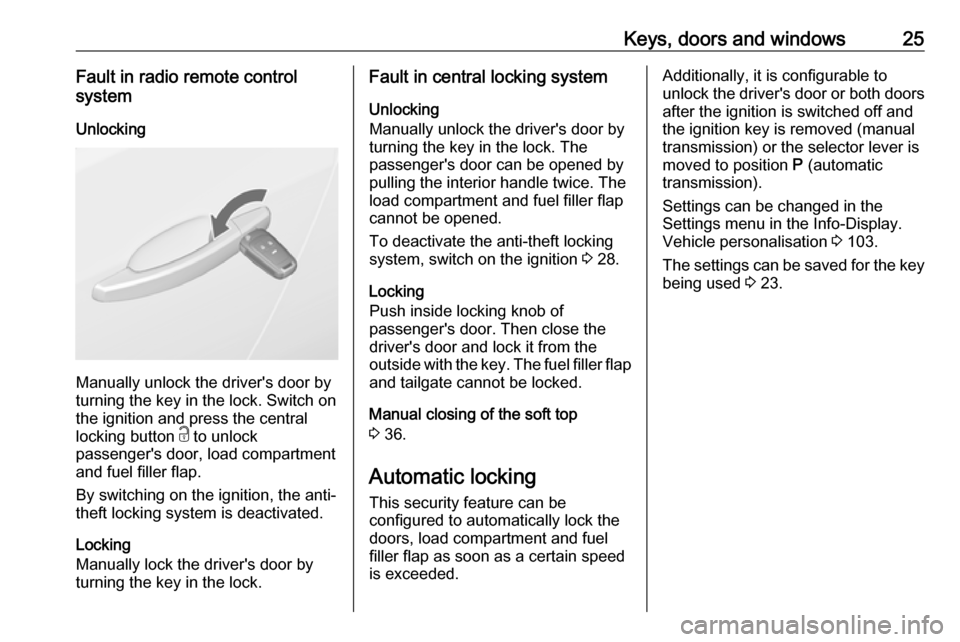
Keys, doors and windows25Fault in radio remote control
system
Unlocking
Manually unlock the driver's door by
turning the key in the lock. Switch on
the ignition and press the central
locking button c to unlock
passenger's door, load compartment
and fuel filler flap.
By switching on the ignition, the anti- theft locking system is deactivated.
Locking
Manually lock the driver's door by
turning the key in the lock.
Fault in central locking system
Unlocking
Manually unlock the driver's door by
turning the key in the lock. The
passenger's door can be opened by
pulling the interior handle twice. The
load compartment and fuel filler flap
cannot be opened.
To deactivate the anti-theft locking system, switch on the ignition 3 28.
Locking
Push inside locking knob of
passenger's door. Then close the
driver's door and lock it from the
outside with the key. The fuel filler flap
and tailgate cannot be locked.
Manual closing of the soft top
3 36.
Automatic locking
This security feature can be
configured to automatically lock the
doors, load compartment and fuel
filler flap as soon as a certain speed
is exceeded.Additionally, it is configurable to
unlock the driver's door or both doors after the ignition is switched off and
the ignition key is removed (manual
transmission) or the selector lever is
moved to position P (automatic
transmission).
Settings can be changed in the
Settings menu in the Info-Display. Vehicle personalisation 3 103.
The settings can be saved for the key
being used 3 23.
Page 31 of 267
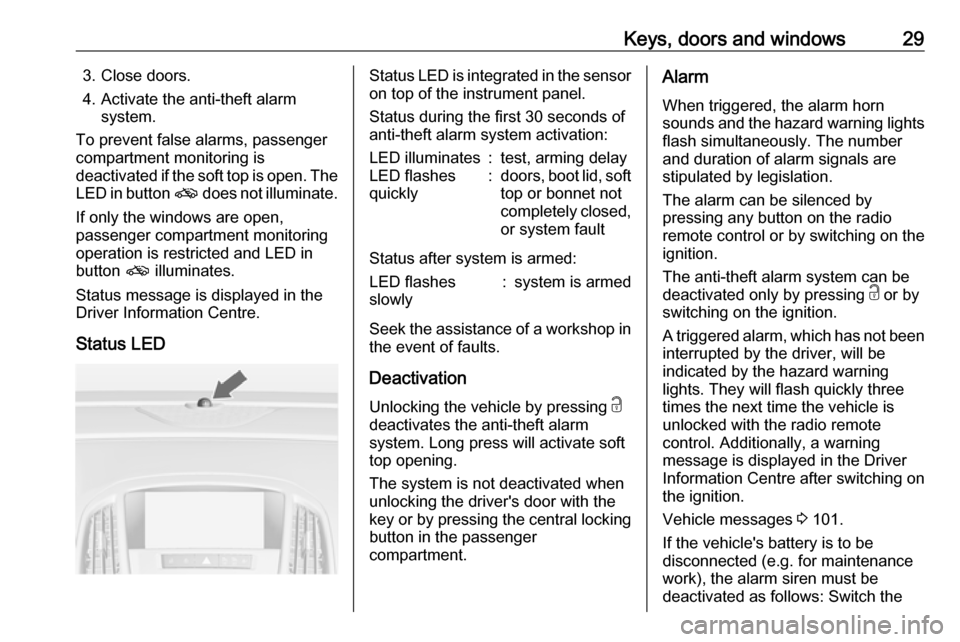
Keys, doors and windows293. Close doors.
4. Activate the anti-theft alarm system.
To prevent false alarms, passenger compartment monitoring is
deactivated if the soft top is open. The
LED in button o does not illuminate.
If only the windows are open,
passenger compartment monitoring
operation is restricted and LED in
button o illuminates.
Status message is displayed in the
Driver Information Centre.
Status LEDStatus LED is integrated in the sensor
on top of the instrument panel.
Status during the first 30 seconds of
anti-theft alarm system activation:LED illuminates:test, arming delayLED flashes
quickly:doors, boot lid, soft
top or bonnet not
completely closed, or system fault
Status after system is armed:
LED flashes
slowly:system is armed
Seek the assistance of a workshop in
the event of faults.
Deactivation Unlocking the vehicle by pressing c
deactivates the anti-theft alarm
system. Long press will activate soft top opening.
The system is not deactivated when
unlocking the driver's door with the
key or by pressing the central locking
button in the passenger
compartment.
Alarm
When triggered, the alarm horn
sounds and the hazard warning lights
flash simultaneously. The number
and duration of alarm signals are
stipulated by legislation.
The alarm can be silenced by
pressing any button on the radio
remote control or by switching on the
ignition.
The anti-theft alarm system can be
deactivated only by pressing c or by
switching on the ignition.
A triggered alarm, which has not been interrupted by the driver, will be
indicated by the hazard warning
lights. They will flash quickly three
times the next time the vehicle is
unlocked with the radio remote
control. Additionally, a warning
message is displayed in the Driver
Information Centre after switching on
the ignition.
Vehicle messages 3 101.
If the vehicle's battery is to be
disconnected (e.g. for maintenance
work), the alarm siren must be
deactivated as follows: Switch the
Page 37 of 267

Keys, doors and windows35●Press e once more for longer: the
soft top and the windows will be
closed. Press and hold e until soft
top is completely closed.
Release e during closing of the
soft top: movement stops for
10 seconds; pressing e once
more continues closing.
● If the soft top is already closed but windows are opened:
pressing e for two seconds will
close the windows.
Confirmation
Completed opening or closing of the soft top is confirmed by the hazard
warning flashers.
Overload
If the windows are repeatedly
operated within short intervals, the
window operation is disabled for
some time.Initialising the power windows
If the windows cannot be closed
automatically (e.g. after
disconnecting the vehicle battery), a
warning message is displayed in the
Driver Information Centre.
Vehicle messages 3 101.
Activate the window electronics for
each window, beginning with the rear windows, as follows:
1. Soft top must be closed.
2. Close doors.
3. Switch on ignition.
4. Pull switch to the second detent until the window starts to close,
and hold for an additional
4 seconds.
5. Push switch to the second detent until the window starts to open
automatically.
6. Repeat for each window.Heated rear window
Operated by pressing Ü.
The LED in the button indicates
activation.
Heating works with the engine
running and is switched off
automatically after a short time.
Heated rear window is deactivated
when the soft top is opened.
Sun visors
The sun visors can be folded down or swivelled to the side to prevent
dazzling.
Page 51 of 267

Seats, restraints49Note
Approved accessories may only be
attached if the seat is not in use.Front seats
Seat position9 Warning
Only drive with the seat correctly
adjusted.
9 Danger
Do not sit closer than 25 cm to the
steering wheel, to permit safe
airbag deployment.
9 Warning
Never adjust seats while driving as
they could move uncontrollably.
9 Warning
Never store any objects under the
seats.
● Sit with buttocks as far back against the backrest as possible.
Adjust the distance between the
seat and the pedals so that legs
are slightly angled when pressing the pedals. Slide the front
passenger seat as far back as
possible.
● Set seat height high enough to have a clear field of vision on allsides and of all display
instruments. There should be at
least one hand of clearance
between head and the roof
frame. Your thighs should rest
lightly on the seat without
pressing into it.